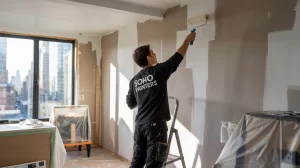Ceilings are traditionally painted white to absorb light and make a room feel spacious. But if you want to break out of the mold, painting your walls and ceiling with one color can be a bold choice.
But to pull it off, the color you choose will need to fit the size of the room and the aesthetic you’re going for. So if you’re still unsure if this is the right move for your house, we’ll break down the pros and cons of painting your ceiling the same colors as the walls to help you make your decision.
Pros of painting walls and ceiling the same color
Makes painting easier
You have to admit, painting your walls and ceiling the same color will make your work ten times easier – especially if your walls don’t have trims since you won’t have to worry about painting outside the lines.
Although it’s still recommended to cut in the edges, painting is still quicker since you don’t have to spend time taping corners and keeping an extra steady hand. Using one color is also cost-effective since you’ll only need one type of paint. As long as you estimate the right amount you need to cover your house, you won’t have any extra buckets sitting around your storage.
The room can look larger
If you have a small room that you want to look more spacious, painting the walls and ceiling the same light color is one neat trick that many don’t know.
That’s because it makes the lines of the room flow through each other, making the space look bigger than it is. You can still apply this if your house already has high ceilings and want to exaggerate the space.
The trick also works if you want to hide the slopes and angles on the ceilings since using the same color will camouflage the transition line toward the walls.
Creates a bold statement
If you want to create a unique home, painting your walls and ceiling the same color is one way of making a bold statement. When done right, your friends and family will surely remember it since you don’t often see it in traditional homes.
Rich and dark colors, like navy blue or maroon, can make your home feel moody or cozy, while pastel hues keep it light and airy. But if you want to keep the color minimal, an all-white home can make your space look cleaner.
Cons of painting the walls and ceiling the same color
The room can look smaller
In contrast to painting a small room with a light color, using a dark hue will make your space look smaller. Instead of giving your house a sense of depth, it’s going to feel claustrophobic or overwhelming instead. This is especially true if your space doesn’t have windows since natural light can’t come in.
So if you’re going for a cozy feel, try to look for a color that’s a shade or two lighter than its solid version. You can also use a different color for the trims or light fixtures to create a break from the color.
It can make the space feel overwhelming
If you don’t shy away from bold and bright colors for your home, painting the ceiling and walls with one loud hue can make it look overwhelming to your eyes.
Think how orange, red, or yellow paint can look in your home, especially in a small room. But if you still want to add a pop of color to your house, tone it down a couple of shades or use paint with a matte finish so it’s not as intense.
It can hide the features of a room
You must admit that painting your wall and ceiling with one color can sometimes make it look monotonous since it can hide away the features of intricate molding or camouflage a detailed light fixture.
If you don’t want to take these features away from the limelight, consider creating an accent wall instead. It will still allow you to make a statement while preventing the details of the room from blending into the color.
Is it better to paint the ceiling or walls first?
Painting your walls may be more convenient because they’re easier to reach. But the pros recommend you paint from top to bottom, which means you should start on the ceiling.
That’s because if you get drips on the walls from painting the ceiling, you can easily cover them later once you move on to the walls. Although drips won’t be a problem using one paint color, they can still create bumps on the surface if you don’t even them out. So the same rules apply, even if you use the same paint hue for your walls and ceiling.
Tips for painting your walls and ceiling the same color
To make sure painting your ceiling and walls with one color doesn’t end in disaster, here are some tips you can keep in mind during the process:
- Take the size of the room into consideration when choosing your paint color. Remember, dark shades make it look smaller, while light hues make it look bigger.
- If you’re using a rich color, don’t forget to paint the trims the same color to create an elegant feel. If you like, you can also paint the door the same color to blend it in.
- Use the same paint finish on your walls and ceiling to make the room look cohesive.
- Consider playing around with monochromatic colors or patterns on your furniture to prevent your home from looking monotonous.
Need help with painting your walls?
If you’re ready to paint your ceiling and walls, Soho Painters can help. They have a team of professional painters equipped with high-quality materials and training to give you the best results. They also offer wallpapering and exterior painting services to ensure your home gets the makeover it deserves. For questions or inquiries, feel free to reach out to their team now and book a free estimate.





